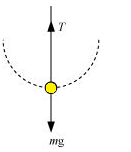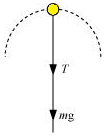


| Lowest Point | Highest Point | |
| a | mg – T1 | mg + T2 |
| b | mg + T1 | mg – T2 |
| c | mg + T1 – (mv12) / R | mg – T2 + (mv12) / R |
| d | mg – T1 – (mv12) / R | mg + T2 + (mv12) / R |


Given,
Mass of the helicopter, mh = 1000 kg
Mass of the crew and passengers, mp = 300 kg
Total mass of the system, m = 1300 kg
Acceleration of the helicopter, a = 15 m/s2
Using Newton’s second law of motion, the reaction force R,
R – mpg = ma
= mp(g + a)
= 300 (10 + 15)
= 300 × 25
= 7500 N
The reaction force will be directed upwards, the helicopter is accelerating vertically upwards.
According to Newton’s third law of motion, the force on the floor by the crew and passengers = 7500 N, directed downward.
(b)
Using Newton’s second law of motion, the reaction force R’ experienced by the helicopter can be calculated as,
R' - mg = ma
= m(g + a)
= 1300 (10 + 15)
= 1300 × 25
= 32500 N
The reaction force experienced by the helicopter from the surrounding air is acting upward. Hence, as per Newton’s third law of motion, the action of the rotor on the surrounding air will be 32500 N, directed downward.
(c) The force on the helicopter due to the surrounding air is 32500 N, directed upwards.
